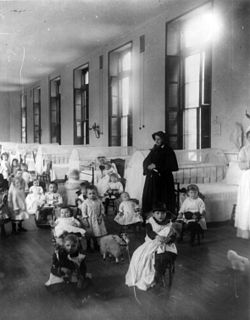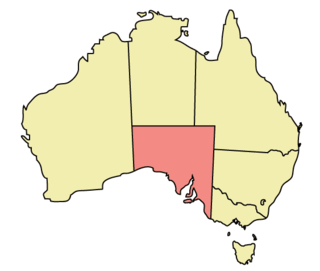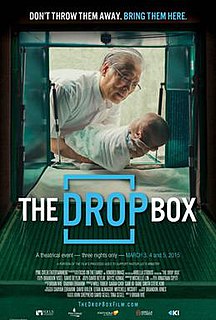
Adoption is a process whereby a person assumes the parenting of another, usually a child, from that person's biological or legal parent or parents. Legal adoptions permanently transfer all rights and responsibilities, along with filiation, from the biological parent or parents.
The international adoption of South Korean children started as a result of a large number of orphaned mixed children from the Korean War after 1953. Religious organizations in the United States, Australia, and many Western European nations slowly developed into the apparatus that sustained international adoption as a socially integrated system. This system, however, is essentially gone as of 2020. The number of children given for adoption is lower than in comparable OECD countries of a similar size, the majority of adoptees are adopted by South Korean families, and the number of international adoptees is at a historical low.
International adoption is a type of adoption in which an individual or couple becomes the legal and permanent parent(s) of a child who is a national of a different country. In general, prospective adoptive parents must meet the legal adoption requirements of their country of residence and those of the country whose nationality the child holds.
Disruption is ending an adoption. While technically an adoption is disrupted only when it is abandoned by the adopting parent or parents before it is legally completed, in practice the term is used for all adoptions that are ended. It is usually initiated by the parents via a court petition, much like a divorce, to which it is analogous.
In the United States, adoption is the process of creating a legal parent-child relationship between a child and a parent who was not automatically recognized as the child's parent at birth.
Interracial adoption refers to the act of placing a child of one racial or ethnic group with adoptive parents of another racial or ethnic group.
Family preservation was the movement to help keep children at home with their families rather than in foster homes or institutions. This movement was a reaction to the earlier policy of family breakup, which pulled children out of unfit homes. Extreme poverty alone was seen as a justified reason to remove children. This new movement began in the 1890s, and in the 1909 White House Conference on Children it was the top ranked issue. In order to keep families together, the family would be given enough money so that the mother would not have to work a full-time job. The families that were given this assistance were usually headed by widows.
Adoption in Australia deals with the adoption process in the various parts of Australia, whereby a person assumes or acquires the permanent, legal status of parenthood in relation to a child under the age of 18 in place of the child's birth or biological parents. Australia classifies adoptions as local adoptions, and intercountry adoptions. Known child adoptions are a form of local adoptions.

Lesbian, gay, bisexual, and transgender (LGBT) rights in Queensland have advanced significantly from the late 20th century onwards, in line with progress on LGBT rights in Australia nationally. Private consensual sex between men has been legal in the state since 1991, with lesbian sexual acts never criminalised. The age of consent was equalised to 16 years for all sexual acts in 2016. Sexuality and gender identity are protected attributes under both state and federal anti-discrimination laws. Same-sex couples may marry under Australian law, enter into a civil partnership under state law or live together in an unregistered de facto relationship. Same-sex couples may become parents through adoption, foster care, altruistic surrogacy and, for lesbian couples, IVF. In 2020, Queensland became the first jurisdiction within Australia to pass a law banning conversion therapy, with a maximum penalty of 18 months imprisonment and fines.

The traditional family structure in the United States is considered a family support system involving two married individuals — one man and one woman — providing care and stability for their biological offspring. However, this two-parent, heterosexual, nuclear family has become less prevalent, and nontraditional family forms have become more common. The family is created at birth and establishes ties across generations. Those generations, the extended family of aunts and uncles, grandparents, and cousins, can hold significant emotional and economic roles for the nuclear family.

The rights of lesbian, gay, bisexual, and transgender (LGBT) people in the Australian state of South Australia are advanced and well-established. South Australia has had a chequered history with respect to the rights of LGBT people. Initially, the state was a national pioneer of LGBT rights in Australia, being the first in the country to decriminalise homosexuality and to introduce a non-discriminatory age of consent for all sexual activity. Subsequently, the state fell behind other Australian jurisdictions in areas including relationship recognition and parenting, with the most recent law reforms regarding the recognition of same-sex relationships, LGBT adoption and strengthened anti-discrimination laws passed in 2016 and went into effect in 2017.
Law in Australia with regard to children is often based on what is considered to be in the best interest of the child. The traditional and often used assumption is that children need both a mother and a father, which plays an important role in divorce and custodial proceedings, and has carried over into adoption and fertility procedures. As of April 2018 all Australian states and territories allow adoption by same-sex couples.
The following outline is provided as an overview of and topical guide to adoption:
Forced adoption in Australia was the practice of taking babies from unmarried mothers, against their will, and placing them for adoption. In 2012 the Australian Senate Inquiry Report into Forced Adoption Practices found that babies were taken illegally by doctors, nurses, social workers and religious figures, sometimes with the assistance of adoption agencies or other authorities, and adopted to married couples. Some mothers were coerced, drugged and illegally had their consent taken. Many of these adoptions occurred after the mothers were sent away by their families 'due to the stigma associated with being pregnant and unmarried'. The removals occurred predominantly in the second half of the twentieth century. It was a practice which has been described as 'institutionalised baby farming'.
A maternity home, or maternity housing program, is a form of supportive housing provided to pregnant women. Maternity housing programs support a woman in need of a stable home environment to reach her goals in a variety of areas including education, employment, financial stability, prenatal care, and more. There are over 400 maternity homes in the United States ranging in size and criteria for admittance. Staffing model is a primary way that maternity homes differ. The three major staffing models are houseparents, live-in staff, and shift staff. Additionally, there are a limited number of maternity housing program who operate as a "shepherding" or "host" home. In the "host home" model, women are connected to screened households that offer to provide housing.

Adoption in the Philippines is a process of granting social, emotional and legal family and kinship membership to an individual from the Philippines, usually a child. It involves a transfer of parental rights and obligations and provides family membership. The Department of Social Welfare and Development (DSWD) defines adoption as a "socio-legal process of giving a permanent family to a child whose parents have voluntarily or involuntarily given up their parental rights."

The Drop Box is a 2015 documentary directed by Brian Ivie about pastor Lee Jong Rak and his work with abandoned children in South Korea. The film was produced by Arbella Studios and Pine Creek Entertainment, and distributed by Fathom Events. The film had a cumulative worldwide gross of $3,300,000. Since the establishment of the drop box outside the Jusarang Community Church, hundreds of abandoned children have been received and adopted in Seoul, South Korea.

The Infants' Home Child and Family Services was established in Sydney, Australia in 1874 as a refuge for unwed mothers and their babies and evolving over time to a current provider of early childhood education and health services.
Teenage pregnancy in Korea carries a lot of stigma resulting in many abortions and adoptions. Very few pregnant teens keep the child because, along with stigma, it is very difficult for them to get help. The stigma can result in isolation from friends and family, expulsion from school, homelessness, and more. Teenagers are not legally allowed to make the decision of what to do with the pregnancy because the majority are underage and need their parents consent. Nineteen is the legal age of adulthood where they could decide for themselves. Parents often choose abortion or adoption rather than keeping the child even if the teenager wanted. Some who want to keep the child often end up hiding it or planning to run away to avoid the stigma and opinions of those around them.
Birth mothers in South Korea refers to the group of biological mothers whose children were given up for adoption in South Korea's international adoption practice. The decades-long phenomenon of international adoption in South Korea began after the Korean War. In the years since the war, South Korea has become the largest and longest provider of children placed for international adoption, with 165,944 recorded Korean adoptees living in 14 countries, primarily in North America and Western Europe, as of 2014.






